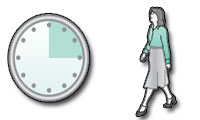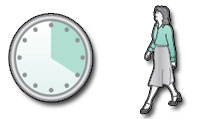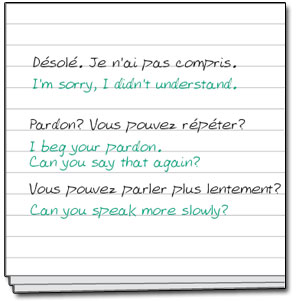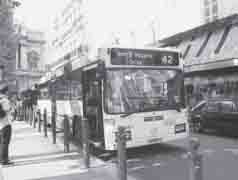2.2.4 Getting about
Saying how to get about
Earlier (Session 1) you met the expression:
à pied on foot
Other ways of saying how people get about include:
à bicyclette by bicycle
en voiture by car
en avion by plane
en taxi in a taxi
en bus by bus
en vélo by bicycle
en train by train
You can say how far away somewhere is:
C'est à trois minutes à pied. It's a three-minute walk away.
C'est à dix minutes en voiture. It's a ten-minute drive away.
C'est à quinze minutes en bus. It's fifteen minutes away by bus.
Activité 16
A friend asks you how to get to several destinations. Use the pictures to answer the questions. Remember to start your answer with C'est…
Lisez les questions. Donnez les réponses à haute voix.
Exemple
Pour aller à l'hôpital? C'est loin?
VousC'est à dix minutes en voiture.

Je voudrais aller au marché. C'est loin?

Pour aller à la gare? C'est loin?

Je voudrais aller à la piscine. C'est loin?

Pour aller au commissariat du quartier? C'est loin?

Answer
C'est à quinze minutes à pied.
C'est à cinq minutes en voiture.
C'est à vingt minutes à pied.
C'est à trois minutes en voiture.
Activité 17
1. Listen to Extract 50 and find out in which dialogue the tourist asks for the directions to be repeated, and in which dialogue the person from Avignon is asked to speak more slowly.
Écoutez
Transcript: Audio 12
2. Try to identify the phrases that are used to ask for clarification and repetition.
Identifiez les expressions
Answer
Dialogue 1
The tourist asks her informant to repeat the information, by saying:
Pardon, monsieur, je n'ai pas compris. Vous pouvez répéter?
Dialogue 2
The tourist asks her informant to speak more slowly, by saying:
Désolée, madame, je n'ai pas compris. Vous pouvez parler plus lentement?

Activité 18
1. You are asking for directions at the office du tourisme. Study the following dialogue and make notes, to prepare for your part.
Étudiez le dialogue et préparez votre rôle.
La réceptionniste Je peux vous aider?
VousExcuse me. How do I get to the centre d'Art contemporain? Is it far?
La réceptionniste Oui, c'est loin. C'est boulevard Raspail. C'est à trente minutes à pied. Mais vous avez le bus.
VousI beg your pardon. Can you repeat that?
La réceptionniste Oui, le centre est loin d'ici. C'est à trente minutes à pied. Mais vous avez le bus, c'est à dix minutes en bus.
VousWhere is the stop?
La réceptionniste L'arrêt? Euh, quai de Ligne. À côté du pont.

2. Now take part in the dialogue in Extract 51. Speak after the receptionist.
Écoutez et parlez dans les pauses.
Answer
Check your answers against the audio clip and the dialogue shown here.
Dialogue Here is the dialogue:
Extrait 51
La receptionniste Je peux vous aider?
Vous Pardon. Pour aller au centre d'Art contemporain? C'est loin?
La réceptionniste Ah oui, c'est loin. C'est boulevard Raspail. C'est à trente minutes à pied. Mais vous avez le bus.
Vous Pardon, vous pouvez répéter?
La réceptionniste Oui, le centre est loin d'ici. C'est à trente minutes à pied. Mais vous avez le bus, c'est à dix minutes en bus.
Vous L'arrêt, c'est où?
La réceptionniste L'arrêt? Euh, quai de Ligne. À côté du pont.
Developing your oral fluency
Another way of improving the way you speak is to listen to one of the participants in a dialogue and say their part at the same time. This will help you in particular to improve pronunciation and intonation – ensuring for example that you differentiate between asking a question and giving an answer.
